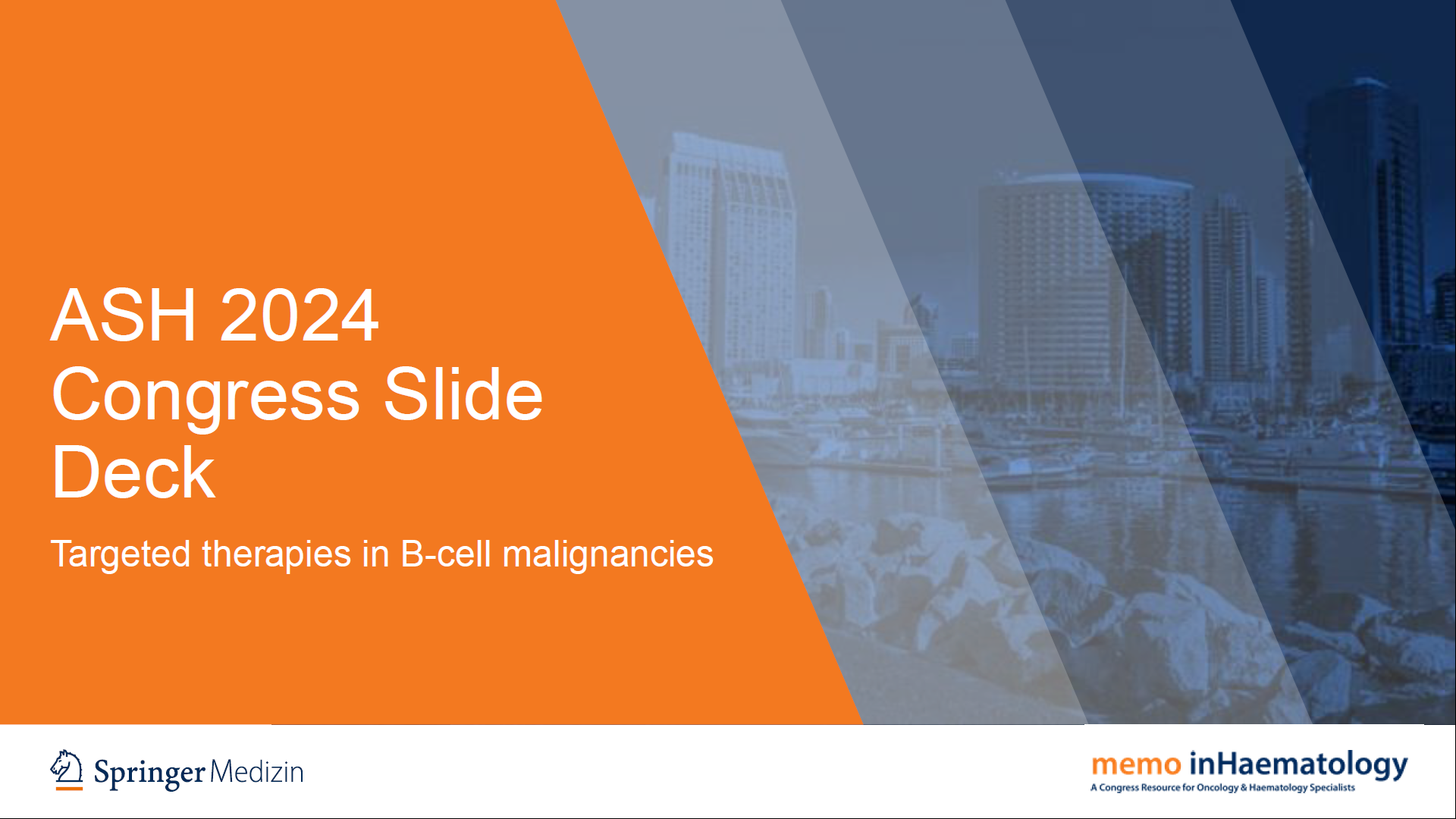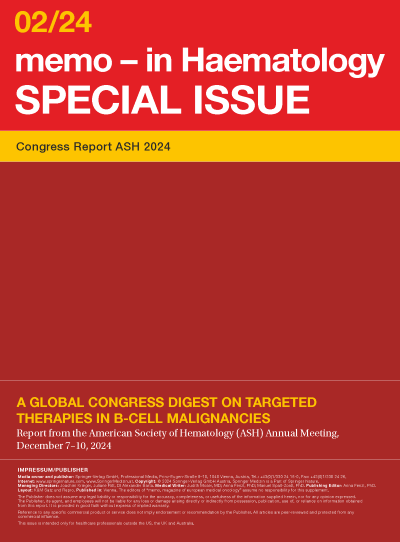ASH 2024 – hybrid
Lecture Board: Othman Al-Sawaf, MD; Lukas Kazianka, MD; Wojciech Jurczak, MD, PhD; Ingrid Glimelius, MD, PhD; Stephan Stilgenbauer, MD
Medical Writer: Judith Moser, MD; Anna Fenzl, PhD; Manuel Spalt-Zoidl, PhD
Publishing Editor: Anna Fenzl, PhD
Editorial – ASH 2024
The 66th Annual Meeting of the American Society of Hematology (ASH), held as a hybrid event from December 7th to 10th, 2024, in San Diego, California, USA, set a new benchmark with over 7,950 abstracts accepted for presentation.
Pushing the boundaries further in the management of CLL
In patients with treatment-naïve chronic lymphocytic leukemia (CLL), the multicenter, open-label, randomized, phase III AMPLIFY trial was initiated to evaluate fixed-duration treatment with acalabrutinib plus venetoclax ± obinutuzumab compared to investigator’s choice of chemoimmunotherapy (CIT).
Follicular lymphoma: Efficacy and safety updates
In the context of follicular lymphoma treatment, there is a clear unmet need for patients who have experienced early progression (progression within 24 months of front-line therapy, POD24), as well as those who are refractory to treatment and present with other high-risk features. At ASH 2024, promising efficacy and safety data were reported for the five molecules nemtabrutinib, zanubrutinib, BGB-16673, epcoritamab, and mosunetuzumab [1-6].
Advancing care in Waldenström macroglobulinemia: Clinical and real-world perspectives
Recent advances have transformed the management of Waldenström macroglobulinemia (WM), particularly with the advent of targeted therapies such as Bruton tyrosine kinase (BTK) inhibitors. These innovations have addressed longstanding challenges including resistance, intolerance, and the need for personalized approaches (enabling therapy also for those deemed unfit for chemotherapy).
Mantle cell lymphoma: optimizing responses in treatment-naïve and difficult-to-treat patients
The three-arm, randomized, phase III TRIANGLE trial has set a new first-line standard in younger patients with mantle cell lymphoma (MCL), showing that the addition of ibrutinib to standard immunochemotherapy improves efficacy [1]. Previously untreated patients aged 18-65 years who were eligible for autologous stem cell transplantation (ASCT) were randomized to either induction treatment with R-CHOP and R-DHAP followed by ASCT (group A; n = 288) or one of two experimental arms: In group A+I (n = 292), ibrutinib was added to R-CHOP and was administered as fixed-duration maintenance for two years after ASCT.
ASH 2024 EXPERT INTERVIEWS
Jorge Castillo discusses the relative efficacy and safety of BTK inhibitors with or without BCL2 inhibitors in Waldenström’s macroglobulinemia (WM), highlights important prognostic molecular markers in untreated patients, and reveals new insights into the biology of the disease. He also explores novel therapeutic targets that may shape the future of WM treatment.
Matthew S. Davids provides insights into the potential of the new drug class of protein degraders in CLL treatment and discusses recently identified biomarkers that are prognostic or predictive in the era of targeted therapy. He also evaluates the performance of BTK-inhibitor-based treatments in high-risk CLL or after prior exposure to targeted agents and explores strategies to overcome real-world barriers to guideline- and evidence-based care in CLL.
Paolo Ghia delves into the ongoing debate between fixed-duration and continuous targeted therapies in CLL, focusing on their respective impacts on long-term survival outcomes. He highlights cellular mechanisms that enable MRD cells to survive despite BTK inhibition and shares his personal highlights from this year’s ASH conference, emphasizing those with the most significant impact on clinical practice.
Shirley D’Sa highlights the ASPEN trial’s key insights on durable responses with zanubrutinib monotherapy in Waldenström’s macroglobulinemia, explores promising results for the radiopharmaceutical iopofosine in pretreated patients, and shares real-world data from the global registry WhiMSICAL on how therapies impact patients’ quality of life.
John Seymour elucidates the promising outcomes of BTK degraders in hematological malignancies, as for example demonstrated in the CaDAnCe-101 trial, and reflects on their future role in treatment strategies. He delves into the pros and cons of fixed-duration versus continuous therapy in CLL and highlights the clinical significance of clonal hematopoiesis in patients with CLL.
Piers Patten discusses the potential of next-generation BCL-2 inhibitors like sonrotoclax compared to venetoclax in the treatment of CLL and shares insights on factors predictive of early MRD responses to BTK/BCL-2 inhibition in patients with CLL. He also provides an overview of the current understanding of the tumor microenvironment’s role in follicular lymphoma, highlighting key findings presented at ASH.
Efstathios Kastritis provides insights into the efficacy of ibrutinib-based treatments for Waldenström’s macroglobulinemia and discusses the current state of research on resistance mechanisms to BTK inhibitors and strategies to overcome them. He also reflects on how modern therapies have transformed real-world outcomes for patients, offering a comprehensive perspective on the evolving treatment landscape of Waldenström’s macroglobulinemia.
Jennifer A. Woyach summarizes the current knowledge on BTK mutations and their clinical relevance in patients with CLL receiving BTK inhibitor therapy. She explains how patients fare after discontinuing BTK inhibitors due to toxicity and highlights the potential of next-generation BTK inhibitors, such as zanubrutinib, in combination with BCL-2 inhibitors like sonrotoclax for treatment-naïve CLL.
Meghan C. Thompson discusses outcomes in patients with CLL and Richter transformation after discontinuation of non-covalent BTK inhibitors, explores how first-line treatment duration in CLL can be personalized based on MRD kinetics, and highlights the potential of innovative approaches like BTK degraders and bispecific antibodies in relapsed/refractory CLL.





